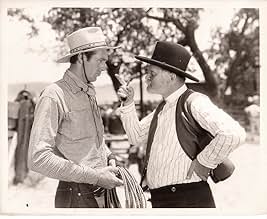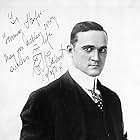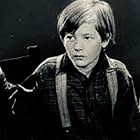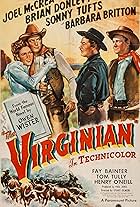A good-natured cowboy who is romancing the new schoolmarm has a crisis of conscience when he discovers that his best friend is engaged in cattle rustling.A good-natured cowboy who is romancing the new schoolmarm has a crisis of conscience when he discovers that his best friend is engaged in cattle rustling.A good-natured cowboy who is romancing the new schoolmarm has a crisis of conscience when he discovers that his best friend is engaged in cattle rustling.
- Awards
- 3 wins total
- Saloon Singer
- (uncredited)
- …
- Little Boy
- (uncredited)
- Minor Role
- (uncredited)
- Student
- (uncredited)
- Fred
- (uncredited)
- Little Boy
- (uncredited)
- Bug Ears
- (uncredited)
- Little Boy
- (uncredited)
Storyline
Did you know
- TriviaGary Cooper's first all-talking film. He felt that sound would ruin him, believing his voice was not adequate to the task. This film turned him from a promising young leading man into a star, although he was not considered a superstar until Mr. Deeds Goes to Town (1936).
- GoofsWhen the posse spots the rustlers, The Virginian says that the posse will split into three parties, then splits them only in two.
- Quotes
Trampas: Well, who's talkin' to you?
The Virginian: I'm talkin' to you, Trampas!
Trampas: When I want to know anything from you, I'll tell ya, you long-legged son-of-a -...
The Virginian: [Trampas stops talking abruptly as the Virginian's pistol is pressed against his abdomen] If you want to call me that, smile!
Trampas: With a gun against my belly, I - I always smile!
[He grins broadly]
- Alternate versionsThis movie was also issued in a silent version, with film length of 2257.65 meters.
- ConnectionsFeatured in Born to the West (1937)
- SoundtracksPop! Goes the Weasel
(uncredited)
A 17th-century English children's song
Played at the dance
The plot development set in Wyoming introduces the nameless cowboy known to all simply as The Virginian (Gary Cooper) mainly because he's from Virginia. Working as a foreman of the Box H Ranch near Medicine Row, his best pal, Steve (Richard Arlen), a free-spirited cowboy, believes there's a better way to earn money than working. It so happens that, unknown to the Virginian, Steve is connected with Trampas (Walter Huston, in traditional villain role of thick mustache and dark hat) and his gang of cattle rustlers. Arriving from the Union Pacific train is Molly Stark Wood (Mary Brian), the new schoolteacher in town. Her beauty finds The Virginian and Steve rivaling for her affection. At first Molly dislikes The Virginian and devotes her attention to Steve, even with these two acting like little boys playing jokes on one another. Eventually the laughs come to an end as Steve, Pedro (Charles Stevens) and Jim (James Mason) are caught by a posse for cattle rustling, forcing the Virginian to take leadership in their hanging execution the next morning. Before Steve dies, he leaves The Virginian his name engraved gun. Because Trampas is responsible, The Virginian sets out to get him, but on the very day of his wedding to Molly, Trampas threatens the Virginian to leave town before sundown, causing the future groom-to-be faced of being branded a coward or forced to go against Molly's wishes and risk losing her by going on the one on one showdown with Trampas. Others in the supporting cast include: Helen Ware (Mrs. Taylor); Eugene Palette (Honey Wiggen); Chester Conklin (Uncle Hughey); Victor Potel (Nebrasky); George Chandler, Ed Brady and Nena Quartero in smaller roles.
Regardless of its age and familiarity, THE VIRGINIAN is an oldie but a goody. "When you call me that, SMILE!" and "Get out of town by sundown" are the film's most famous quotes. Notable scenes include the Virginian and Steve's greeting each other to the whistling sound of a quail; Molly's reaction to her schoolroom of children singing "Three Blind Mice" off-key; Virginian and Steve switching infants in separate room prior to their christening; The Virginian's reaction when having to participate in Steve's execution and hearing an actual quail's whistling prior to it; tense moments between the Virginian and Trampas, among others. Unlike early talkies of the time, THE VIRGINIAN is well paced for 90 minutes, and refrains from actresses, mainly Mary Brian, from overacting in the silent film tradition by allowing her to give a more natural performance. Aside from scenes set in bars or hotel rooms, much of it outdoor scenery appears authentic rather than a closed set with phony painted background. THE VIRGINIAN may seem strange to contemporary viewers where underscoring is non-existent, unless one counts the mooing sounds of cattle steer heard during the opening credit titles. Unlike some early talkies, there's no inter-titles depicting what's to take place in the next scene to come.
Next to The Marx Brothers comedy, THE COCOANUTS, THE VIRGINIAN seemingly appears to have been the only other Paramount theatrical release from 1929 made available to broadcast television with frequent revivals in the sixties, seventies and onward, indicating its popularity decades after its initial release. When distributed to video cassette in the early 1990s, the clam-shell box labeled the 1929 edition as the original version, overlooking the fact that there were two earlier silent editions that preceded it: 1914 (Dustin Farnum) and 1923 (Kenneth Harlan). Paramount remade the newly Technicolor and underscored edition of THE VIRGINIAN (1946) starring Joel McCrea, Brian Donlevy and Barbara Britton in the Cooper, Huston and Brian roles, with more emphasis on Molly than on the titled character. THE VIRGINIAN also became the basis of a television series starring James Drury in the 1960s.
Unseen on cable television since its presentation on American Movie Classics (1994-1999), THE VIRGINIAN (1929), along with other frequently shown screen adaptations as the 2000 TV movie, turns up occasionally on Encore Westerns, most commonly after sundown where programs directors smile when they do that. (***)
- How long is The Virginian?Powered by Alexa
Details
Box office
- Budget
- $425,000 (estimated)
- Runtime1 hour 31 minutes
- Color
- Aspect ratio
- 1.20 : 1
- 1.37 : 1
Contribute to this page



































